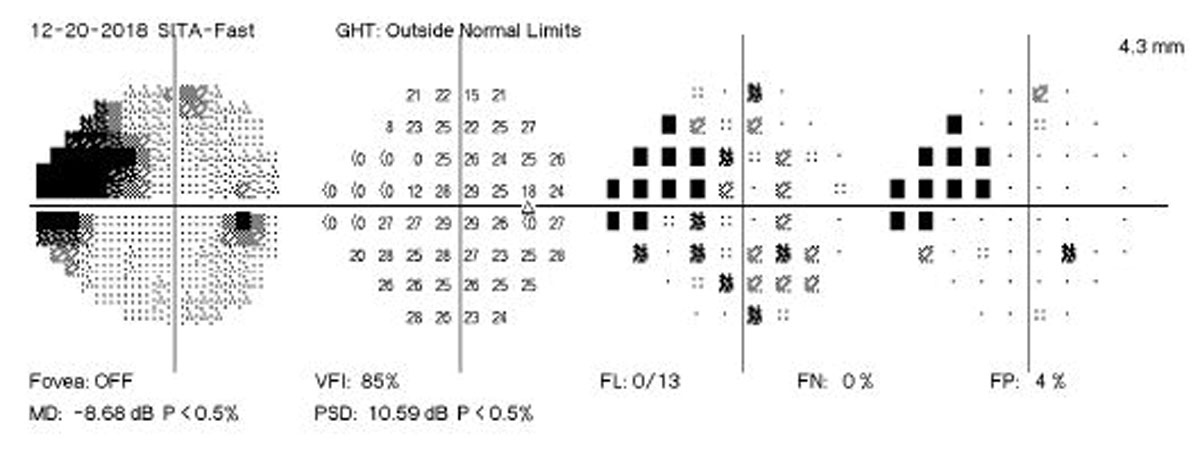 |
Different locations of VF damage in glaucoma could have varied impacts on vision-related QoL even among individuals with the same MD values. Photo: Brian D. Fisher, OD. Click image to enlarge. |
It’s no surprise to anyone that visual function deficits in glaucoma impact patient quality of life (QoL). But new research seeks to raise awareness among clinicians to the factors that have the biggest impact. Understanding the status of binocular contrast sensitivity function and specific defect patterns of binocular field loss might be beneficial for a realistic estimation of the daily visual function, according to a team of researchers from India.
The group aimed to understand the influence of monocular and binocular visual function parameters (specifically, contrast sensitivity and VF defect) on vision-related QoL using questionnaires presented to patients in different stages of glaucoma but with spared central acuity. The research team found that, while poor scores were reported with increasing disease severity, disease severity and compromised visual functions were found to contribute predominantly to the poor Glaucoma Quality of Life-15 (GQL-15) scores, and mental health and social dependency scores were influenced by gender along with VF defect severity influenced Visual Function Questionnaire-Utility Index (VFQ-UI) scores.
A total of 154 glaucoma patients with a median age of 61 (range: 24-83) years were enrolled. The participants underwent monocular and binocular VA, contrast sensitivity assessment followed by the monocular perimetry from which the Integrated VF were estimated (binocular summation method). Vision-related QoL was evaluated using the GQL-15 and VFQ-UI questionnaires. The relationship between contrast sensitivity and VF defect with the composite vision-related QoL scores was analyzed.
Those with severe VF defect reported poor composite scores for both questionnaires when compared with unilateral and mild groups. Both the composite scores were negatively correlated with monocular and binocular contrast sensitivity and VF mean deviation. Binocular VF defect in the inferior central zone contributed to poor GQL-1 5score irrespective of gender while females with increasing binocular VF defect reported poor QoL score in VFQ-UI.
The study also demonstrated a better relationship between QoL scores and mean deviation (MD) values than contrast sensitivity values. “A better correlation of MD values with QoL scores than CS could be due to the wider range in MD values (dB) with increasing disease severity compared with the limited testing range for contrast sensitivity (Log units),” the authors wrote in their paper. Worse-eye MD values did not much influence the QoL scores compared to the better and binocular MD values. According to the study’s results, glaucoma patients with severe VF defect have a 10-times higher chance of reporting poor GQL-15 scores than subjects with mild VFD in their better eye.
Female subjects had a four-times higher chance of reporting poor QoL scores in the VFQ-UI compared with males. The researchers proposed that “the contributing factors for the poor mental health or social dependency in females could be their educational level or cultural restrictions in developing countries like India.”
“Despite intact central visual acuity, glaucoma participants reported poor QoL scores for central and near-vision domains with increasing disease severity, which could be due to the defective paracentral points observed in the later stages of the disease,” they noted.
Nagarajan S, Negiloni K, Asokan R, et al. Impact of monocular and binocular visual function parameters on vision-related quality of life in glaucoma. J Glaucoma. July 31, 2023. [Epub ahead of print]. |

